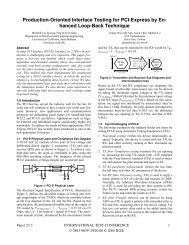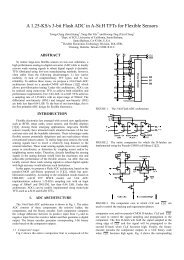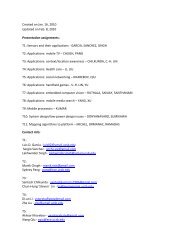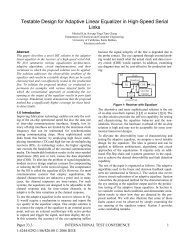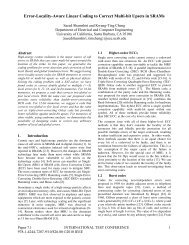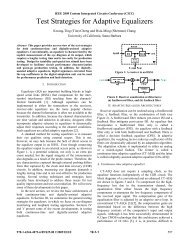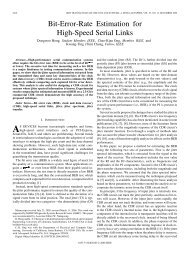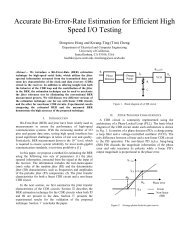Testing 1 - UCSB SoC Design and Test Lab
Testing 1 - UCSB SoC Design and Test Lab
Testing 1 - UCSB SoC Design and Test Lab
Create successful ePaper yourself
Turn your PDF publications into a flip-book with our unique Google optimized e-Paper software.
© K.-T. Cheng, component.ppt, v1.0<br />
1<br />
Outline - Overview<br />
Overview of IC <strong><strong>Test</strong>ing</strong><br />
• Types of <strong><strong>Test</strong>ing</strong> at IC level<br />
• IC Production <strong>Test</strong> Process<br />
• Burn-in<br />
• Board, System <strong>and</strong> Field <strong><strong>Test</strong>ing</strong><br />
• Costs of <strong><strong>Test</strong>ing</strong><br />
• The <strong><strong>Test</strong>ing</strong> Problems<br />
© K.-T. Cheng, component.ppt, v1.0<br />
2
VLSI Realization Process<br />
Customer’s need<br />
Determine requirements<br />
Write specifications<br />
<strong>Design</strong> synthesis <strong>and</strong> Verification<br />
<strong>Test</strong> development<br />
Fabrication<br />
Manufacturing test<br />
*from M. Bushnell/V. Agrawal<br />
Chips to customer<br />
© K.-T. Cheng, component.ppt, v1.0<br />
3<br />
Verification vs. <strong>Test</strong><br />
! Verifies correctness of design.<br />
! Performed by simulation,<br />
hardware emulation, or formal<br />
methods.<br />
! Performed once prior to<br />
manufacturing.<br />
! Responsible for quality of<br />
design.<br />
! Verifies correctness of manufactured<br />
hardware.<br />
! Two-part process:<br />
– 1. <strong>Test</strong> generation: software process<br />
executed once during design<br />
– 2. <strong>Test</strong> application: electrical tests applied<br />
to hardware<br />
! <strong>Test</strong> application performed on every<br />
manufactured device.<br />
! Responsible for quality of devices.<br />
*from M. Bushnell/V. Agrawal<br />
© K.-T. Cheng, component.ppt, v1.0<br />
4
Errors And Faults<br />
! <strong>Design</strong> errors<br />
– violations of design rules<br />
– incorrect mapping between different levels of design<br />
– incomplete or inconsistent specification<br />
! Fabrication errors - caused by human errors<br />
– incorrect wiring<br />
– shorts caused by improper soldering<br />
! Fabrication defects - caused by imperfect<br />
manufacturing process<br />
– mask alignment errors<br />
– improper doping profiles<br />
© K.-T. Cheng, component.ppt, v1.0<br />
5<br />
! Physical failures - due to component wear-out<br />
<strong>and</strong>/or environmental factors<br />
– connectors may break due to electronmigration<br />
or corrosion<br />
– temperature, humidity <strong>and</strong> vibrations<br />
accelerate the aging of components<br />
– infancy failures<br />
© K.-T. Cheng, component.ppt, v1.0<br />
6
Problems of Ideal <strong>Test</strong>s<br />
! Ideal tests detect all defects produced in the<br />
manufacturing process.<br />
! Ideal tests pass all functionally good devices.<br />
! Very large numbers <strong>and</strong> varieties of possible defects<br />
need to be tested.<br />
! Difficult to generate tests for some real defects. Defectoriented<br />
testing is an open problem.<br />
*from M. Bushnell/V. Agrawal<br />
© K.-T. Cheng, component.ppt, v1.0<br />
7<br />
Real <strong>Test</strong>s<br />
! Based on analyzable fault models, which may<br />
not map on real defects.<br />
! Incomplete coverage of modeled faults due to<br />
high complexity.<br />
! Some good chips are rejected. The fraction (or<br />
percentage) of such chips is called the yield loss.<br />
! Some bad chips pass tests. The fraction (or<br />
percentage) of bad chips among all passing<br />
chips is called the defect level.<br />
© K.-T. Cheng, component.ppt, v1.0<br />
8
<strong><strong>Test</strong>ing</strong> as Filter Process<br />
Good chips<br />
Prob(pass test) = high<br />
Prob(good) = y<br />
Fabricated<br />
chips<br />
Defective chips<br />
Prob(bad) = 1- y<br />
Prob(fail test) = high<br />
Prob(fail<br />
test) = low<br />
Prob(pass test) = low<br />
Mostly<br />
good<br />
chips<br />
Mostly<br />
bad<br />
chips<br />
© K.-T. Cheng, component.ppt, v1.0<br />
9<br />
Types of <strong><strong>Test</strong>ing</strong> - IC Level<br />
! Characterization - determine the device’s characteristics<br />
– AC <strong>and</strong> DC characteristics<br />
– data will be used for final spec.<br />
– data can be used to identify area in which processing can<br />
be helped for increased yield<br />
– test time is not important<br />
! Production testing<br />
– Contact test<br />
– Burn-in testing<br />
– Functional testing<br />
– Parametric testing<br />
© K.-T. Cheng, component.ppt, v1.0<br />
10
Production <strong><strong>Test</strong>ing</strong> for ICs<br />
Contact<strong>Test</strong><br />
Burn-In <strong>Test</strong><br />
To screen out assembly related failures.<br />
To insure that the tester interface is in<br />
contact with the device.<br />
To screen out infant mortalities<br />
Functional <strong>Test</strong><br />
DC Parametric <strong>Test</strong><br />
Steady state tests<br />
AC Parametric <strong>Test</strong><br />
To ensure that state changes<br />
occurattherighttime<br />
© K.-T. Cheng, component.ppt, v1.0<br />
11<br />
DC Parametric <strong><strong>Test</strong>ing</strong><br />
! <strong>Test</strong>s are done by Parametric<br />
Measurement Unit (PMU)<br />
– Leakage test<br />
– Threshold V iL &V iH test<br />
– Output drive current test<br />
– Power consumption test<br />
– Output short current test<br />
© K.-T. Cheng, component.ppt, v1.0<br />
12
AC Parametric <strong><strong>Test</strong>ing</strong><br />
! To ensure that value/state changes occur at the<br />
right time<br />
! Some of AC parametric tests are mainly for<br />
characterization <strong>and</strong> may not be necessary for<br />
production test.<br />
– <strong>Test</strong> for rise <strong>and</strong> fall times of an output signal<br />
– <strong>Test</strong>s for setup <strong>and</strong> hold times<br />
– <strong>Test</strong>s for time to tri-state<br />
– <strong>Test</strong>s for measuring delay times<br />
» E.g. tests for memory access time<br />
– Functional at-speed tests (speed sorting)<br />
© K.-T. Cheng, component.ppt, v1.0<br />
13<br />
Functional <strong><strong>Test</strong>ing</strong> for Digital Circuits<br />
<strong>Test</strong><br />
Vectors<br />
…. 01<br />
…. 00<br />
….<br />
…. 01<br />
True<br />
Response<br />
Digital<br />
Circuit<br />
Comparator<br />
….<br />
Circuit<br />
Response<br />
11…. 10….<br />
…<br />
.<br />
01….<br />
<strong>Test</strong><br />
Result<br />
© K.-T. Cheng, component.ppt, v1.0<br />
14
Failure rate<br />
Typical Bathtub Curve of IC’s<br />
Failure Rate<br />
Earlyfailure<br />
period<br />
Useful-life period<br />
Wearout<br />
period<br />
Cumulative operating time<br />
~1,000 hours >10years<br />
© K.-T. Cheng, component.ppt, v1.0<br />
15<br />
Burn-in <strong><strong>Test</strong>ing</strong><br />
! Correlations have been made between life span at room<br />
temperature & life span at elevated temperature.<br />
! Charts of these correlations have been made for each<br />
technology<br />
! Put the device in a furnace for a certain length of time at<br />
an elevated temperature <strong>and</strong> voltage<br />
– By applying high voltage to the IC’s pins, burn-in<br />
accelerates the time-to-failure of oxide defects (weak<br />
oxide, pin holes, uneven layer growth, etc) typically<br />
found in MOS devices<br />
– High temperature accelerates these <strong>and</strong> other defects,<br />
such as ionic contamination <strong>and</strong> silicon defects<br />
© K.-T. Cheng, component.ppt, v1.0<br />
16
High-Voltage Stress <strong>Test</strong>s<br />
! Mainly for memory chips<br />
! Cycling through all addresses using selected memory<br />
data patterns for several seconds, both logic high <strong>and</strong><br />
logic low, with 7.5V forcing function being applied<br />
(for a 5V rated part)<br />
! IC memory suppliers have used this test in lieu of<br />
dynamic burn-in as a means to uncover oxide defects<br />
in MOS IC’s<br />
! Some use it in conjunction with either dynamic burnin<br />
or TDBI<br />
© K.-T. Cheng, component.ppt, v1.0<br />
17<br />
<strong>Test</strong> During Burn-In<br />
! The most comprehensive burn-in technique<br />
! Procedure:<br />
– Devices are operated at 125 ° C <strong>and</strong> elevated voltage (7-7.5V) for<br />
an extended period of time, while all DUT’s are subjected to<br />
functional testing using a complex test<br />
– The DUT’s are operated for a short duration at a lower temp.<br />
70 ° C <strong>and</strong> voltage (5.5V) during which parametric testing is<br />
performed<br />
– Repeat the above two steps for 4-8 hours or longer<br />
! Used primarily for DRAM<br />
– But not for large memories due to the long electrical test times<br />
– Not appropriate for EPROM, microprocessors <strong>and</strong> other VLSI<br />
devices<br />
© K.-T. Cheng, component.ppt, v1.0<br />
18
Board Level <strong><strong>Test</strong>ing</strong><br />
! Shorts testing<br />
! In-circuit testing<br />
– Check devices already mounted on a board<br />
– An external tester applies patterns directly to the<br />
inputs of the device & observe the outputs<br />
– The tester must be capable of electronically isolating<br />
the IC under test from the board environment<br />
! Functional Board <strong><strong>Test</strong>ing</strong><br />
© K.-T. Cheng, component.ppt, v1.0<br />
19<br />
System <strong><strong>Test</strong>ing</strong><br />
! Final test in the manufacturing<br />
process<br />
! Checking the right assembly of<br />
components such as boards,<br />
backplanes, cables <strong>and</strong><br />
peripherals<br />
! It also involves checking of<br />
component interactions <strong>and</strong><br />
HW/SW functionality<br />
! Very long test times required<br />
© K.-T. Cheng, component.ppt, v1.0<br />
20
Field <strong><strong>Test</strong>ing</strong><br />
! Necessary for commissioning <strong>and</strong> faultfinding<br />
the system as a whole in a fieldservice<br />
environment<br />
! Both analog <strong>and</strong> digital test equipment is<br />
needed, issues of<br />
– Portability<br />
– Ease of use<br />
– Range of functions<br />
© K.-T. Cheng, component.ppt, v1.0<br />
21<br />
<strong><strong>Test</strong>ing</strong> Costs are Composed of:<br />
! <strong>Test</strong> equipment costs<br />
– Analog & digital signal <strong>and</strong> measuring instrumentation<br />
– <strong>Test</strong> head (pin electronics, drivers <strong>and</strong> cables)<br />
– <strong>Test</strong> controller (computer & storage)<br />
! <strong>Test</strong> development costs<br />
– <strong>Test</strong> planning, test program development <strong>and</strong><br />
debugging<br />
! <strong><strong>Test</strong>ing</strong>-time costs<br />
– time using the equipment to support testing<br />
! <strong>Test</strong> personnel costs<br />
– training<br />
– working time<br />
© K.-T. Cheng, component.ppt, v1.0<br />
22
Cost Of <strong><strong>Test</strong>ing</strong> - The Rule of Tens<br />
1000<br />
Cost<br />
Per<br />
Fault<br />
(Dollars)<br />
100<br />
10<br />
1<br />
5.0<br />
50<br />
500<br />
0.5<br />
IC<br />
<strong>Test</strong><br />
Board<br />
<strong>Test</strong><br />
System<br />
<strong>Test</strong><br />
Warranty<br />
Repair<br />
© K.-T. Cheng, component.ppt, v1.0<br />
23



